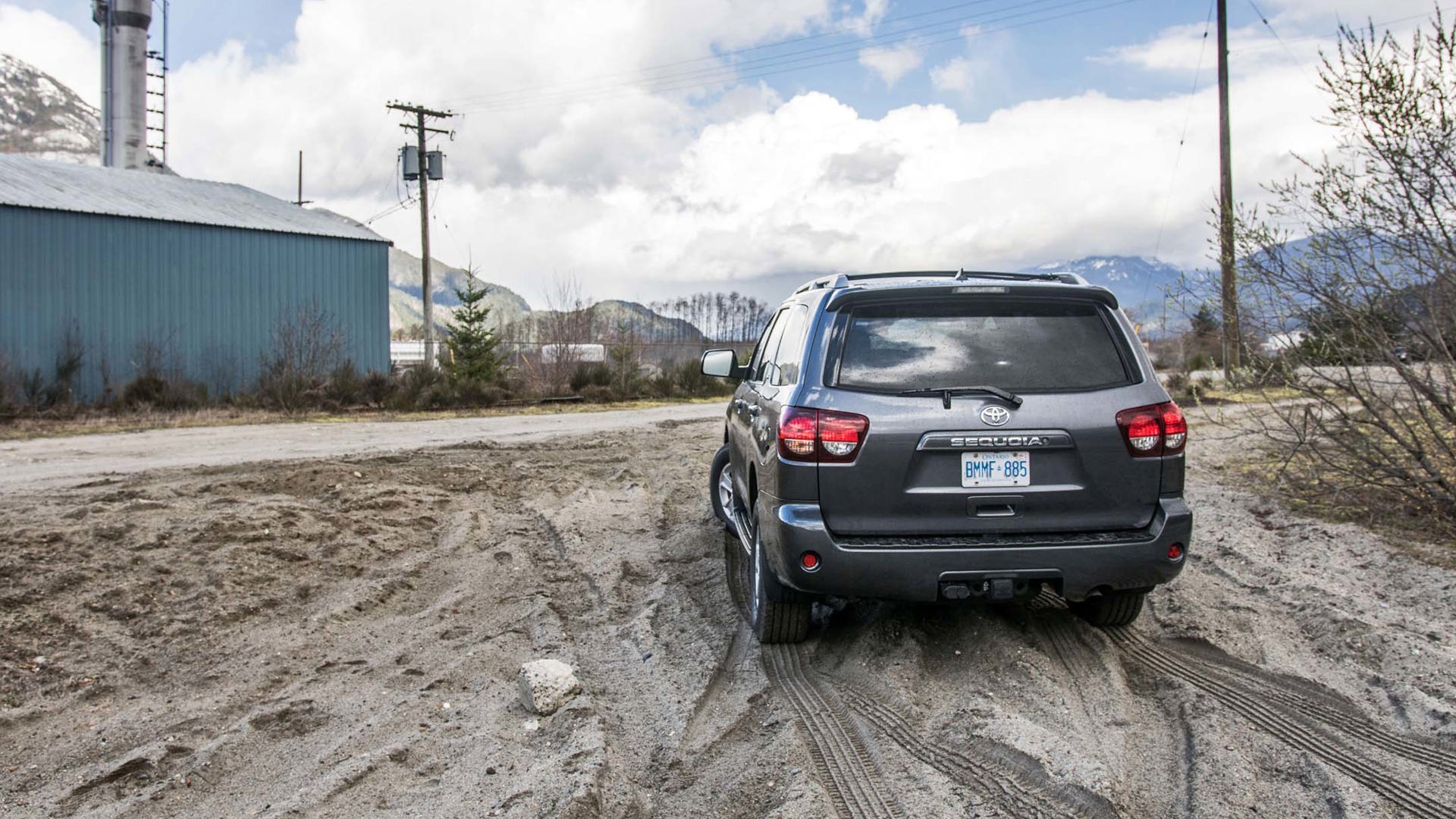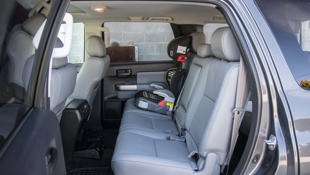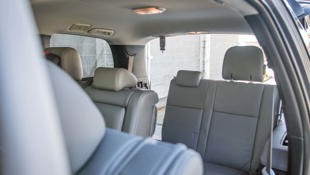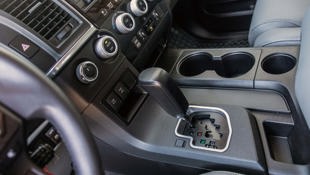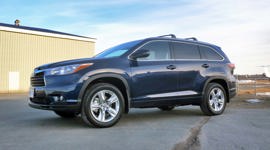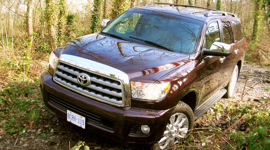 AutoTrader SCORE
AutoTrader SCORE
-
STYLING6/10
-
Safety7/10
-
PRACTICALITY8/10
-
USER-FRIENDLINESS6/10
-
FEATURES6/10
-
POWER7/10
-
COMFORT8/10
-
DRIVING FEEL7/10
-
FUEL ECONOMY4/10
-
VALUE7/10
As of 2018, several manufacturers will happily sell you a fully reconditioned vehicle from their heritage division – think of the Series I Range Rover that JLR charges a trifling $240,000 for. It’s a new old car, for quite a lot of money.
Things the Sequoia is not: sophisticated, elegant, subtle.
Alternatively, you can also purchase an old new car, something like the behemoth we have here. Like the 370Z or the Nissan Frontier, the 2018 Toyota Sequoia is new in construction but really quite elderly in design, having been last comprehensively updated in 2008. Based on the Tundra, it is a body-on-frame SUV in the mould of the Canyonero (smells like a steak, seats thirty-five), and is pretty much the largest Toyota you can buy. At least until rolled-back EPA regulations end up bringing back the Megacruiser.
Things the Sequoia is not: sophisticated, elegant, subtle. Things it is: large, thirsty, fairly expensive.
For 2018, there’s a new front fascia, some LED daytime running lights, and a bit of extra equipment in the form of Toyota’s Safety Sense driving assists.
Like the similarly dated 4Runner, the Sequoia is not without its ancient charms. While modern crossovers bridge the credibility gap of unibody construction with gaping grilles and swathes of touchscreens, the Sequoia is basically a large truck named after a big tree. The rounded styling is muscular but perhaps a little doughy, like a retired hockey enforcer, or a heavyweight MMA fighter turned doughnut-scarfing commentator.
On the inside, the Sequoia is perfectly built to house people who are built like it is. The seats have all the side bolstering of a futon, but are comfortable, spacious, and squishy. All three rows offer excellent headroom, and the power-folding third row has acceptable legroom for an adult (though perhaps not for longer trips). To get more space, you’d pretty much need a minivan.
This is the base SR5 model, which means it will seat up to eight people. Should you wish to take the entire soccer team camping into the backcountry, there’s a new TRD Sport model, which adds Bilstein shocks, uprated sway bars, and 20-inch alloy wheels. I’m not sure I’d bother.
Instead, the base Sequoia offers pretty much everything you might need, with the standard 18-inch alloys providing huge, squishy sidewalls that feel like you’re driving through a marshmallow factory. Yes, the interior is dated and plasticky, but it’s full of hidden cubbies everywhere, from pockets in the door, to a centre console with the kind of floorspace that would cost $1.7M by Vancouver rates.
Buying a proper truck doesn’t have to mean being behind the times in technology. One need only look at the new Ram 1500 and the huge touchscreen interface it gets on higher trims. For the Sequoia, however, owners are left with an old-fashioned and simple layout, including a central touchscreen that looks like an aftermarket option from five years ago.
In some ways, the simplicity is refreshing. Controls for the Sequoia’s air-conditioning and four-wheel-drive controls are right where you need them, and the dashboard is free from clutter. However, the volume and tuning for the stereo is a literal stretch, and some elements are so bulky as to be cartoonish. The shift lever, for instance, is the size of a Christmas ham.
All that bulk results in a lot of space, the main reason you might move up to a Sequoia from a 4Runner. The second row seats three comfortably abreast, or you can fold the centre section down to form a sort of demilitarized zone between squabbling siblings. The split is 40/20/40 for the middle row, and 60/40 in the back. Cargo volume is a colossal maximum of 3,400 L behind the front seats, about half that behind the second row, and a just-okay 535 L with all seats deployed – only a little better than something like a Honda Pilot.
The other main reason a Sequoia might be on your shopping list can be found under the hood, in the form of a 5.7L V8. All-aluminum and equipped with double overhead cams and four valves per cylinder, you have to wonder why it’s not a more common junkyard swap into some kind of nutty drift-car. In the Sequoia, it makes a healthy 381 hp at 5,600 rpm, a peak 401 lb-ft of torque at 3,600 rpm, and comes with a great soundtrack.
Fitted with a six-speed automatic transmission, the Sequoia accelerates like timber down a log flume. It’s quicker in a straight line than you’d expect, which is a little alarming considering its 2,700 kg curb weight. Pull out the ol’ weigh scales and that’s more than 700 kg heavier than either a Highlander or Pilot.
However, such is not really a fair comparison as the Sequoia’s solid body-on-frame construction is made for towing – the SR5 comes with a standard hitch receiver, four- and seven-pin connectors, a transmission cooler and temperature gauge, and trailer sway control. Maximum capacity is 3,220 kg, which is still competitive. Note, however, that body-on-frame SUVs from GM and Ford have advanced significantly, and the Suburban in particular is still a very effective towing machine. It will both out-tow the Sequoia and out-efficiency it.
The latter is probably the biggest drawback to the Sequoia’s throwback engineering. While the pillowy drive is surprisingly controlled, thanks to double-wishbone suspension at all four corners, and the brakes are (just) up to the task, the one thing any owner would find hard to get used to is the Sequoia’s considerable drinking habit.
This is a tree that needs a lot of fertilizer. While official combined consumption figures are supposed to hit somewhere in the mid teens, the Sequoia plodded along, never doing better than an indicated 18 L/100 km, and that included the bulk of the week’s distance spent cruising up and down the Sea-to-Sky highway. With Vancouver’s gasoline prices topping $1.60 per litre, fuelling the Sequoia is like taking a chainsaw to your wallet.
Taking all these factors into consideration, it’s perhaps not much of a surprise that the Sequoia is at or near the bottom of the list for large SUV sales in Canada. The domestics dominate sales, and even the Armada manages to do a little better.
For all that, should you discount the Sequoia entirely? Perhaps not. While the simple layout and lack of advancement don’t add a lot of sizzle, the Sequoia does offer the durable reputation of the Toyota nameplate. In the used market, it’ll likely retain a significant portion of its value, though not in the way that the nearly depreciation-proof 4Runner or Tacoma do.
Thus, if you can get a decent deal on a Sequoia, and/or own a gas station, this big galoot of a Toyota might just do the trick. There’s nothing new under the sun, as they say, and that’s certainly the case here.
| Engine Displacement | 5.7L |
|---|---|
| Engine Cylinders | V8 |
| Peak Horsepower | 381 hp @ 5,600 rpm |
| Peak Torque | 401 lb-ft @ 3,600 rpm |
| Fuel Economy | 18.4/13.8/16.4 L/100 km city/hwy/cmb |
| Cargo Space | 535 / 1,886 / 3,400 L behind 3rd/2nd/1st row |
| Model Tested | 2018 Toyota Sequoia SR5 |
| Base Price | $59,850 |
| A/C Tax | $100 + Green Levy $2,000 |
| Destination Fee | $1,785 |
| Price as Tested | $63,735 |
|
Optional Equipment
None
|
|














